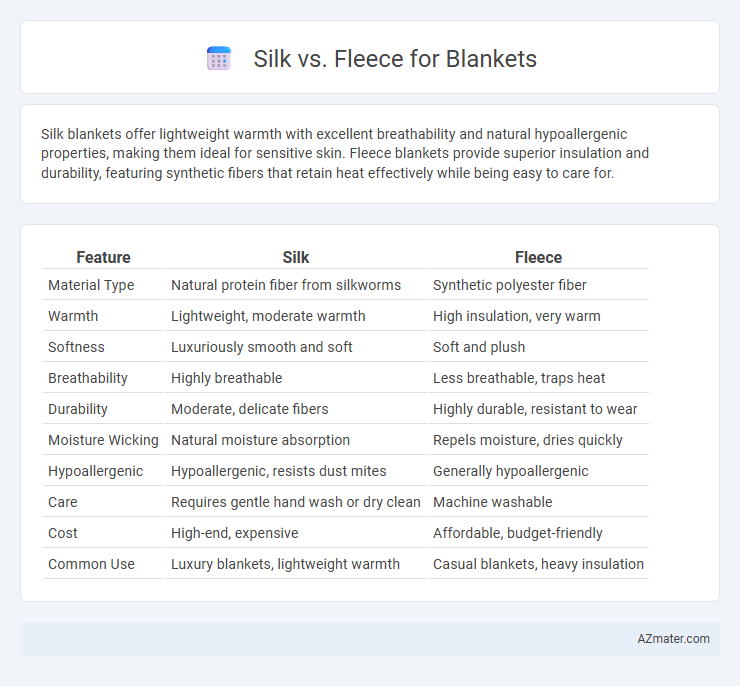Silk blankets offer lightweight warmth with excellent breathability and natural hypoallergenic properties, making them ideal for sensitive skin. Fleece blankets provide superior insulation and durability, featuring synthetic fibers that retain heat effectively while being easy to care for.
Table of Comparison
| Feature | Silk | Fleece |
|---|---|---|
| Material Type | Natural protein fiber from silkworms | Synthetic polyester fiber |
| Warmth | Lightweight, moderate warmth | High insulation, very warm |
| Softness | Luxuriously smooth and soft | Soft and plush |
| Breathability | Highly breathable | Less breathable, traps heat |
| Durability | Moderate, delicate fibers | Highly durable, resistant to wear |
| Moisture Wicking | Natural moisture absorption | Repels moisture, dries quickly |
| Hypoallergenic | Hypoallergenic, resists dust mites | Generally hypoallergenic |
| Care | Requires gentle hand wash or dry clean | Machine washable |
| Cost | High-end, expensive | Affordable, budget-friendly |
| Common Use | Luxury blankets, lightweight warmth | Casual blankets, heavy insulation |
Introduction to Silk and Fleece Blankets
Silk blankets are crafted from natural protein fibers produced by silkworms, renowned for their lightweight, breathable qualities and smooth texture that regulate temperature effectively. Fleece blankets, made from synthetic polyester fibers, offer exceptional warmth, durability, and moisture-wicking properties, making them ideal for cold weather and outdoor use. Both materials have unique thermal and tactile properties, influencing their performance and comfort level in different environments.
Material Origins and Production Processes
Silk blankets originate from the cocoon fibers of the silkworm, primarily produced through a labor-intensive process involving sericulture and delicate reeling of raw silk threads. Fleece blankets are made from synthetic fibers such as polyester, derived from petrochemicals through industrial processes including polymerization and extrusion to create soft, lightweight fabric. The natural protein composition of silk provides breathability and temperature regulation, while fleece's synthetic origin offers durability and moisture-wicking properties.
Texture and Comfort Comparison
Silk blankets offer a smooth, luxurious texture that feels cool and breathable against the skin, making them ideal for sensitive or warm sleepers. Fleece blankets provide a plush, soft surface with excellent warmth retention, perfect for cozy, cold-weather comfort. While silk prioritizes lightweight elegance and moisture-wicking properties, fleece excels in insulating and maintaining a consistently warm environment.
Warmth and Insulation Capabilities
Silk blankets offer lightweight warmth with excellent breathability, making them ideal for mild to moderate temperatures due to their natural thermoregulation and moisture-wicking properties. Fleece blankets provide superior insulation and heat retention, trapping body heat efficiently and maintaining warmth in colder environments thanks to their dense synthetic fibers. Choosing between silk and fleece depends on the desired warmth level and climate conditions, with fleece excelling in insulation and silk offering comfortable warmth without overheating.
Breathability and Moisture-Wicking Properties
Silk blankets excel in breathability due to their natural protein fibers, allowing efficient air circulation and temperature regulation. Fleece blankets, made from synthetic polyester, offer moderate breathability but excel at moisture-wicking, quickly drawing sweat away from the skin to keep users dry. For optimal comfort in varying conditions, silk provides superior airflow, while fleece performs better in managing moisture during active or colder environments.
Durability and Longevity
Silk blankets offer exceptional durability due to their natural protein fibers, resisting wear and maintaining strength over time, while fleece blankets, made from synthetic polyester, provide durability through their resistance to pilling and abrasion. Silk's longevity is enhanced by its ability to regulate temperature and absorb moisture, reducing fiber damage, whereas fleece excels in maintaining warmth and structural integrity even after multiple washes. Choosing between silk and fleece depends on the desired balance between luxury and practicality, with silk favoring long-term elegance and fleece offering robust everyday use.
Maintenance and Care Requirements
Silk blankets require delicate maintenance, including hand washing or dry cleaning, and must be kept away from direct sunlight to prevent fabric damage. Fleece blankets are low-maintenance, machine washable, and dry quickly without special care, making them ideal for everyday use. Proper storage for both materials involves keeping blankets clean and dry to avoid mildew and preserve longevity.
Allergen and Sensitivity Considerations
Silk blankets naturally resist dust mites and mold, making them ideal for individuals with allergies or sensitive skin. Fleece blankets tend to trap allergens like pet dander and dust, which may exacerbate sensitivities or asthma symptoms. Choosing silk over fleece can provide a hypoallergenic and breathable option that minimizes allergic reactions.
Price Range and Value for Money
Silk blankets typically range from $100 to $300, offering exceptional softness, breathability, and hypoallergenic properties that justify their higher price. Fleece blankets are more budget-friendly, usually priced between $20 and $60, providing excellent warmth and durability at a fraction of silk's cost. Evaluating value for money depends on preference for luxury and temperature regulation with silk versus affordability and easy maintenance with fleece.
Choosing the Right Blanket: Silk or Fleece?
Silk blankets offer natural temperature regulation and hypoallergenic properties, making them ideal for sensitive skin and year-round comfort. Fleece blankets provide superior warmth and durability, perfect for colder climates and heavy use. Selecting between silk and fleece depends on your need for breathability versus insulation and maintenance preferences.

Infographic: Silk vs Fleece for Blanket
 azmater.com
azmater.com